|
|
Class |
Insecta |
|
Order |
Homoptera |
|
Family |
Aphididae |
The aphids
constitute a large group of small, soft-bodied insects that are frequently found
in large number sucking the sap from the stem or leaves of plants.
Melon
and green peach aphids attack a number of crops and are vectors of many viruses
attacking sweetpotato and other crops.
Worldwide
in distribution.
Aphids usually attack the growing shoots and expanding leaves. They feed on the lower surface of
the leaves and injure the plants by sucking the sap. The leaves become
deformed as they expand. They may curl down at the
edges, and become wrinkled or puckered. Feeding on expanded leaves (more
common with green peach aphid) may result in pale stippled areas of feeding
damage between the veins.
During heavy infestation, the vigour of
the plant is greatly reduced,
stunting
growth of the plants. Leaves of such stunted plants are pale and may have
yellow interveinal areas.
Both species of aphid transmit several virus diseases in sweetpotato and in other crops.
Infestation of the two aphid species could be differentiated by the
production of the honeydew. M. persicae produces less honeydew than A.
gossypii.
These insects can
be recognized by its pear-like shape, a pair of cornicles
at the posterior end of the abdomen and fairly long antennae; winged forms can
usually be recognized by the venation and relative size of the front and hind
wings.
The cornicles of aphids are tube-like structures arising from the dorsal
side of the fifth or sixth abdominal segment.
Melon aphid
Nymph. The nymphs are green to
brown and moult four times before reaching the adult stage. The nymphs look like
the wingless adults except for their small sizes and softer body.
Adult. The adults are yellowish to
green or black about 1.5 mm long.
Green peach aphid
Nymph. The nymphs are similar to wingless adults but are smaller
in size.
Adult. The adults are small to medium sized, 1.2-2.5 mm long. They are
usually green with darker thorax. The antennae are two-thirds as long as the
body. The cornicles are clavate and fairly long. The face when viewed dorsally
has a characteristic shape. This species generally produces little honeydew.
The life cycle of aphids is rather unusual and complex. The females reproduce
parthenogenetically. Several generations may be produced in short period of
time. The first generation usually consists of wingless individuals, however,
when a colony becomes too crowded,
winged
individuals appear. The winged forms migrate to a different host plant and begin
new colonies, a generation consisting of both males and females is produced, and
the reproductive process continues.
Aphids secrete honeydew which is emitted from the anus; the honeydew consists
mainly of excess sap ingested by the insect, to which are added excess sugars
and waste materials. This honeydew may be produced in sufficient quantities to
cause the surface of leaves to become sticky.
Aphis gossypii - Apart from sweetpotato, this species also damages citrus,
cocoa, coffee, cotton, cucurbits, eggplant, okra, pepper, potato and also
ornamentals like Hibiscus.
Mysus persicae - can occur on bitter gourd, cabbage, cauliflower, condol, chayote, eggplant, lemon, lettuce, loofah, melon, mustard, pechay,
pomelo, potato, raddish, squash, tomato, tobacco, watermelon, and on weeds like Prunus
persica, P. nigra, P. tanella, and P. serotina.
Biological control
The aphids are attacked by a number of ladybird
beetles (Menochilus sexmaculatus, Coelophora inaequalis and
Scymnus sp.) a chrysopid predator (Chysopa oculata), larva
of syrphid fly (Ischiodon scutellaris), spiders (Oxyopes
javanus and Thomisus
sp.), a brachonid wasp (Opius sp.) and entomopathogenic fungi.
Chemical control
Insecticides applicable for aphids include organophosphorous, pyrethroids ,
carbamates and neonicotinoids. Apply insecticides only when necessary.
Aphids have been found to develop resistance to insecticides in areas where they
are regularly used.
Often, preditor insects are more severely affected than the aphid, with the
result that aphid populations increase after insecticide use.
Amalin, D.M. and E. A. Vasquez. 1993. A handbook on Philippine sweetpotato
pests and their natural enemies. International Potato Center (CIP), Los Baños,
Philipppines. 82 p.
Ames, T., Smit,
N.E.J.M., Braun, A.R., O’Sullivan, J.N., and Skoglund, L.G. 1996. Sweetpotato:
Major pests diseases, and nutritional disorders. International Potato Center
(CIP). Lima, Perú. 152 p.
PANS. 1978. Pest Control in Tropical Root Crop. Manual No. 4. Center for
Overseas Pest Research. London 235 p.
Vasquez, E.A. and C.E. Sajise. 1990. Pests of sweet potato: Insects, mites
and diseases. Philippine Root Crop Information Service, Philippine Root Crop
Research & Training Center. 65 p.
Contributed by: Erlinda
Vasquez,
Vilma Amante
and
Jane O'Sullivan |
Taxonomy
Economic
importance
Geographical
distribution
Damage
Morphology
Biology
and ecology
Host
range
Management
References
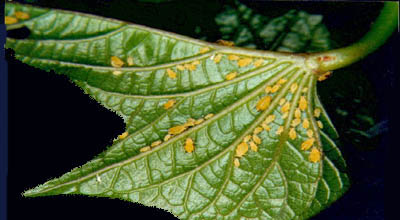
Melon
aphids attacking undersurface of a sweetpotato leaf (E. Vasquez).
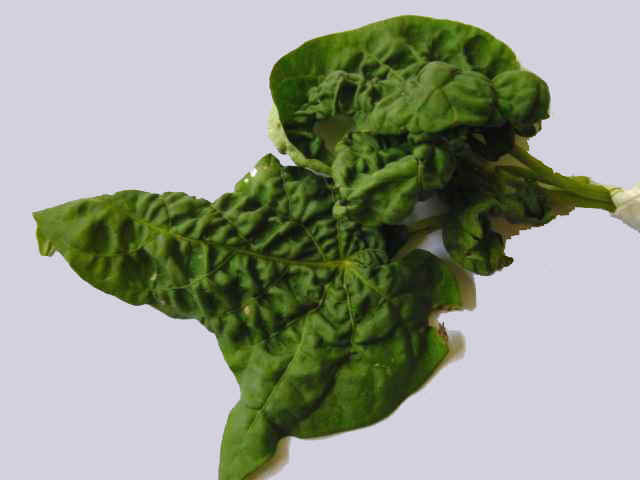
Severely
puckered leaves due to aphid attack (E. Vasquez).

Wrinkling
and curling on leaves due to melon aphid attack (E. Vasquez).
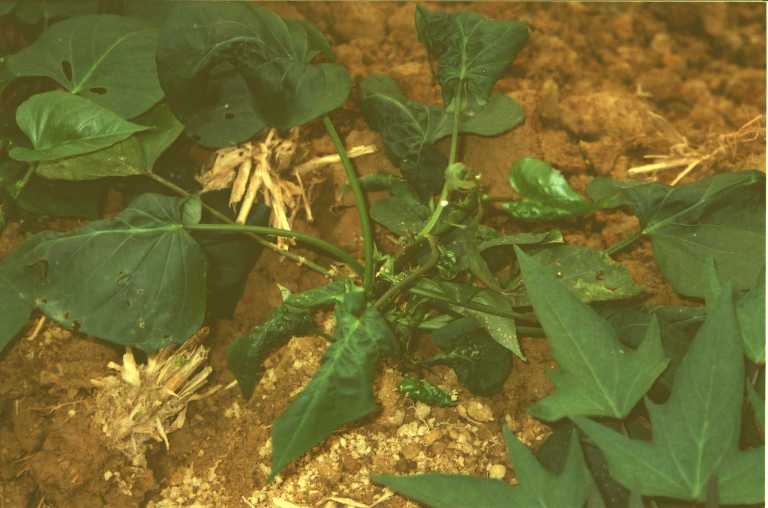
Evidence of melon aphids includes leaf puckering and honeydew, which
makes dust stick to the leaves (J. O'Sullivan).
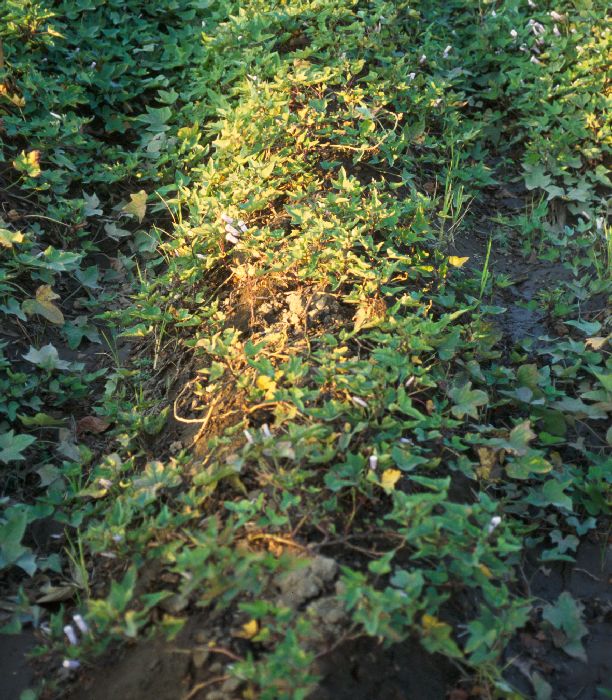
A severely stunted crop having suffered persistent heavy aphid
infestation (J. O'Sullivan).
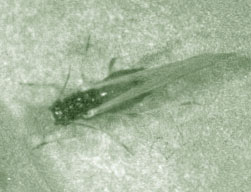
A winged
adult aphid.

Green
peach aphids attacking under surface of a
sweetpotato leaf (E. Vasquez).
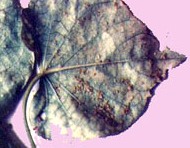
Feeding damage by green peach aphid, seen as pale mottled or speckled
interveinal patches. |

